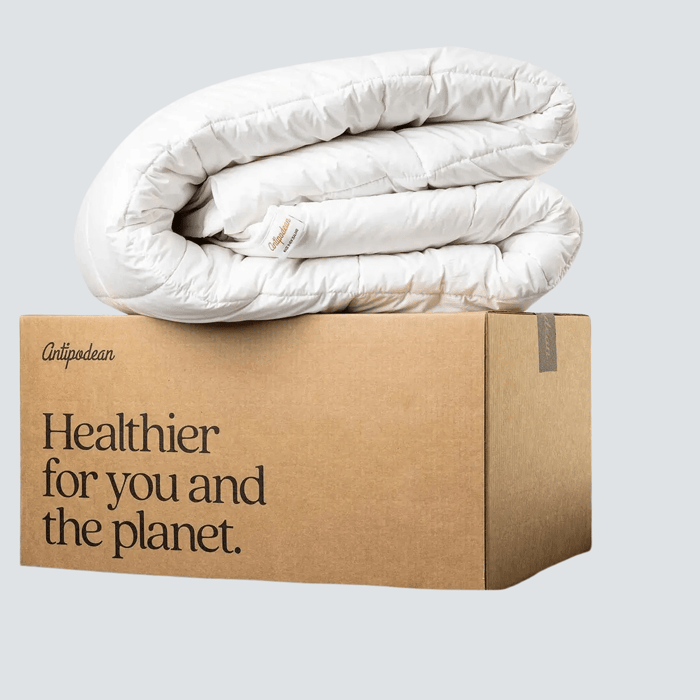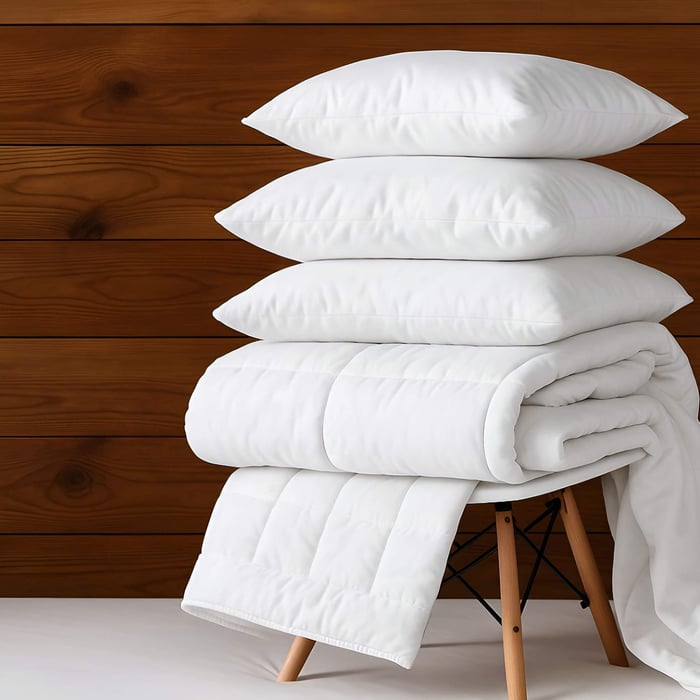Table of Contents
Still sweating through your sheets in the middle of the night? You're not broken — your bedding is. The real culprit? You're probably not sleeping under a cooling wool comforter. Most of us have been duped into thinking wool is only for chilly cabins and sheep-themed sweaters. But here’s the truth bomb: when done right, wool is cool. Literally. It might just be the most misunderstood material in your linen closet. And if you’re still sleeping under plastic masquerading as a comforter? It’s time to change that — fast.
The Myth: Wool Is Too Warm for Summer
We get it. Wool has a cozy, snuggly reputation. But most wool discomfort comes from how it's processed — not from the fiber itself. Traditional wool bedding can be dense, heavy, or coated in synthetic blends that trap heat. That's not how we do things at Antipodean Home.
Our cooling wool comforter uses only regenerative wool, spun using our unique Airlay method. No clumps. No synthetic binders. Just pillowy soft, breathable loft designed to work with your body.The Science: How Wool Keeps You Cool
Wool fibers are naturally crimped, creating tiny air pockets that help regulate temperature and wick away moisture. That means when your body heats up at night, the wool draws that heat and sweat away — allowing your skin to stay cool and dry. Unlike synthetics, which trap moisture and heat, wool is dynamic. It adapts.
Our signature Airlay design enhances this effect by turning regenerative wool into soft, lofty spheres that keep air circulating throughout the comforter. Less clumping. More airflow. Deeper, cooler sleep. Picture a cloud with a PhD in thermoregulation.
 Our cooling wool comforter — made from regenerative New Zealand wool and shipped plastic-free — delivers healthier sleep for you and the planet. Antipodean Home | Made in New Zealand
Our cooling wool comforter — made from regenerative New Zealand wool and shipped plastic-free — delivers healthier sleep for you and the planet. Antipodean Home | Made in New ZealandReal Talk: Why You Still Wake Up Sweaty
Most comforters on the market are made from microfiber — essentially plastic — wrapped in fabric. These materials trap body heat and hold onto moisture. That leads to the dreaded 3am wake-up call, where you kick off the covers soaked in sweat.
But you’re not the problem. Your bedding is.
Switching to a cooling wool comforter can change that overnight. Literally.
Why Synthetic “Cooling” Comforters Can Backfire
Many “cooling” comforters made with microfiber or polyester feel light at first but quickly trap heat and moisture. These man-made fibers can’t regulate humidity the way natural wool can, so hot sleepers often end up tossing, turning, and sweating by 3 a.m. Choosing organic, natural materials means you’re not just staying cooler — you’re also reducing your exposure to petrochemical fabrics and helping the planet breathe easier too.
Wool for Hot Sleepers, Night Sweats, and Hormonal Changes
Wool bedding isn’t just for warm weather — it’s for people whose bodies run hot, all year long. That includes hot sleepers, people with night sweats, and anyone going through menopause or hormonal shifts.
Our cooling wool comforter is naturally hypoallergenic, moisture-wicking, and breathable. That means it works with your body, not against it. You sleep more comfortably, with fewer wake-ups and no soaked sheets.
Let’s be honest — no one wants to strip the bed at 4am. Or explain to your dog why your pillow is now his swamp.
But What About Allergies?
Wool has a bad rap for causing allergies — but most of that comes from low-grade or chemically-treated products. Our wool is naturally hypoallergenic and processed without harsh chemicals. It’s resistant to dust mites, mold, and mildew. So while synthetic comforters are basically welcome mats for allergens, wool is a bouncer at the door.
The Hidden Perk — Drier Nights and Fresher Mornings
Wool doesn’t just manage temperature; our organic wool comforter will also wicks away up to 30% of its weight in moisture without ever feeling damp. That means no clammy sheets, no odor buildup, and no need to wake up to change your pajamas. By morning, your bedding feels fresh and balanced — the way sleep is meant to be.
 Cool mornings, calm nights — our wool bedding keeps you comfortable enough to unwind, read, and truly rest. Antipodean Home | Made in New Zealand
Cool mornings, calm nights — our wool bedding keeps you comfortable enough to unwind, read, and truly rest. Antipodean Home | Made in New ZealandThe Regenerative Difference: Breathability from the Inside Out
Unlike traditional wool, regenerative wool is sourced from farms where soil health and animal wellbeing come first. That care shows up in the fiber itself — finer, softer, and naturally crimped to create millions of tiny air pockets that circulate airflow while you sleep. The result? A comforter that breathes with you, adjusting to your body’s changing temperature throughout the night.
What to Look for in a Summer-Friendly Wool Comforter
Not all wool bedding is created equal. Here’s what to check for:
Regenerative wool: Better for the planet and your skin.
Airlay or open-fill design: More air = more breathability.
No synthetics or binders: Avoid anything that sounds like it came from a chemistry exam.
Lightweight construction: Just enough fill to regulate temperature — not smother you.
Antipodean Home ticks every box. (We made the boxes. And then we filled them with clouds.)
FAQ: Wait, So Wool Can Be Cooling and Cozy?
Yes! Wool doesn't just keep you warm — it keeps you balanced. That means cozy in winter, cool in summer. It's like that one friend who’s always prepared for any situation. Only softer.
Real Reviews: What Customers Say About Our Cooling Wool Comforter
“I was skeptical about wool in summer — but this comforter is a game-changer. No more waking up drenched.” – Aimee, California
“I bought this during a heat wave and I’m never going back. It’s breathable, soft, and the best sleep I’ve had in months.” – Jordan, Arizona
Caring for Your Wool Comforter the Right Way
To keep your cooling wool comforter performing at its best, give it fresh air and sunlight every few months. Spot clean as needed, and skip dry cleaning or harsh detergents — natural wool fibers are self-cleaning and resist odor buildup. A light airing helps restore loft and freshness so your comforter stays breathable and cozy season after season.
Sleep Lighter. Wake Brighter.
Summer sleep doesn’t have to mean tossing and turning. With a cooling wool comforter designed to breathe, you can rest easy knowing your bedding is helping regulate your temperature — not making it worse.
At Antipodean Home, we craft all our bedding with regenerative wool from New Zealand farms. It’s light, it’s airy, and it’s made to help you sleep deeper.
Because when you sleep better, you live brighter.
Try our breathable, organic wool comforter and feel the difference tonight.
Ready to ditch the sweat-soaked nights?
FAQs on Wool Duvet Inserts, Comforters & Sustainable Bedding
Is wool really suitable for hot sleepers?
Yes — it’s one of the best materials for hot sleepers. Wool’s natural crimp allows air to circulate, releasing heat when you’re warm and retaining it when you’re cool. It’s a built-in climate control system for your bed.
How does a wool comforter keep you cool in summer?
Wool fibers absorb and release moisture vapor, helping regulate body temperature through the night. Unlike synthetics, which trap heat, wool actively wicks sweat away — keeping your skin dry and your sleep cycle stable.
Will a wool comforter make me sweat less at night?
Absolutely. Wool draws moisture away from your body and allows it to evaporate naturally. This helps prevent the dampness and overheating that cause night sweats — even in warm, humid climates.
What makes regenerative wool better than regular wool?
Regenerative wool comes from farms that rebuild soil health and biodiversity. The result is a cleaner, softer, more breathable fiber that’s naturally hypoallergenic and completely free from synthetic chemicals or microplastics.
How long does a wool comforter last compared to synthetic or down alternatives?
A well-made wool comforter can last over a decade with proper care — far longer than synthetics that flatten or clump within a few years. It’s an investment in cooler, healthier sleep and a lighter footprint for the planet.




